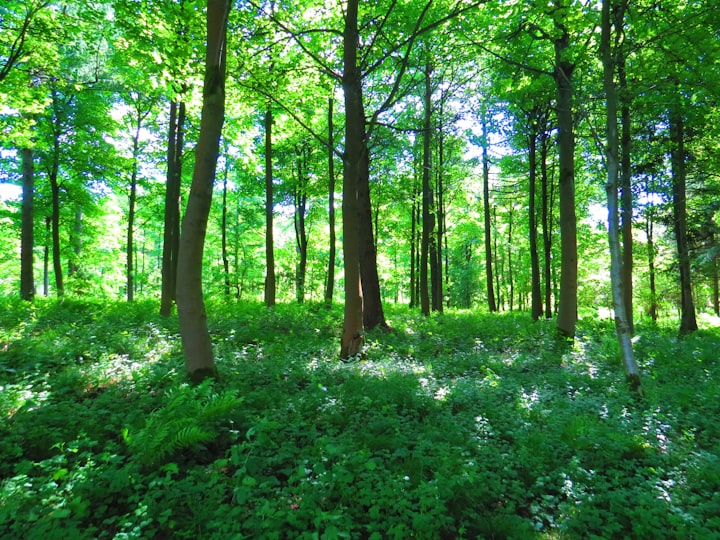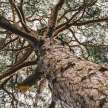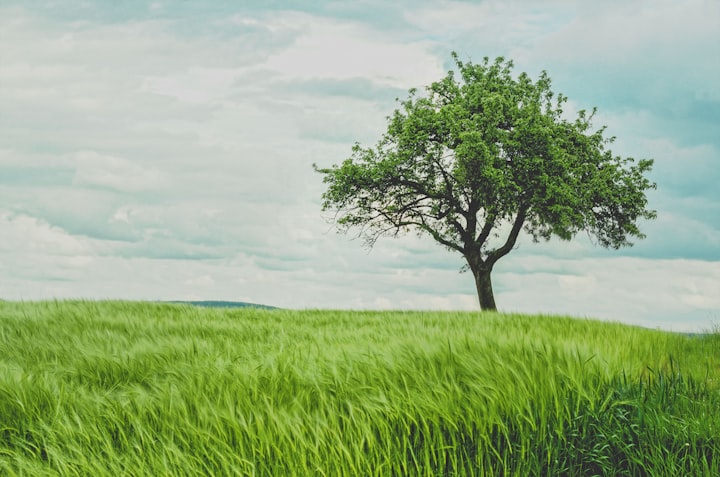
I've already talked a lot about sunlight, and it’s turned out to be an extremely important factor in the forest. This should come as no surprise. After all, trees are plants and need to photosynthesize to survive. But because enough sun usually shines on our garden beds and lawns, in the home garden, water and fertile soil tend to be more decisive factors for plant growth. In our everyday lives, we don’t notice that light is more important, and because we like to apply our own situations to others, we overlook the fact that an intact forest has completely different priorities. In the forest, there’s a battle for every last ray of sunlight, and each species is specialized to grow in a particular niche so that it can soak up some energy, however paltry the amount might be. In the upper story—the executive offices— the mighty beeches, firs, and spruce stretch out and soak up 97 percent of the sunlight. This behavior is cruel and inconsiderate, but doesn’t every species take what it can? Trees have won this competition for the sun because they grow such tall trunks. But a plant can grow a long sturdy trunk only if it lives for a very long time, because an enormous amount of energy is stored in its wood. To grow its trunk, a mature beech needs as much sugar and cellulose as there is in a 2.5-acre field of wheat. Of course, it takes not 1 but 150 years to grow such a mighty structure, but once it’s up there, hardly any other plants—except for other trees—can reach it, and the rest of its life is worry free. Its own offspring are designed to survive in what light remains, and of course, their mothers feed them as well. That is not the case for the rest of the rank and file, and they must come up with other strategies for survival.
Some plants bloom early. In April, seas of frothy white blooms cover the brown earth under old deciduous trees as wood anemones cast their spell on the forest. Sometimes yellow or violet-blue flowers are mixed in, such as liverworts, so-called because their leaves are shaped a bit like human livers. They earned one of their common names in German - V, or “cheeky little ones”—because the flowers appear so early in the year. Liverworts are stubborn plants. Once they’ve found a spot, they want to stay there forever, and they spread very slowly by seed. That’s why you find these early bloomers only in deciduous woods that have been around for at least a few hundred years.
The colorful troupe just about exhausts itself putting on a glorious floral show. The reason for this extravagance is that they want to make the most of the short window of time available to them. While the spring sun warms the forest floor from March to early May, the deciduous trees sleep on. Under the giants’ bare branches, Liverworts & Co. seize the opportunity to produce the carbohydrates they need for the following year. They store the food in their roots. In addition, the little beauties have to reproduce, which uses up additional energy. It’s a small miracle they can pull it all off in just a month or two. As soon as the buds break on the trees, it gets much too dark again, and the flowers are forced to take another ten months off.

When I said earlier that hardly any other plant can reach the tree’s height, the emphasis was on “hardly.” For there are some plants that can make it up into the canopy. It’s particularly arduous and tedious to start right from the bottom. Ivy is one plant that does this. Ivy begins as a small seed at the foot of a tree with an open growth habit—those species that are particularly wasteful with sunbeams and allow any number of them to fall to the forest floor unused. Under pines or oaks, that’s enough for a nice thick carpet of ivy to grow—at first, just on the forest floor. Then, one day, a tendril starts to climb up a trunk. Ivy is the only plant in Central Europe that uses small aboveground roots to anchor itself firmly to bark. Over the course of many decades, the ivy keeps climbing upward until it finally reaches the crown. It can live many hundreds of years up here, though ivy that old is more often found on rocky cliffs or castle walls. Some of the European literature suggests that ivy doesn’t hurt the trees it grows on. After observing the trees growing around our house, I can’t support this view. Quite the opposite, in fact. Pines need a lot of light for their needles, and they particularly resent this competitor taking over in the treetops. Branches begin to die, and this can weaken trees so much that they give up. Ivy vines encircling trunks can grow as thick as small trees, and like boa constrictors winding themselves around their victims, they can squeeze the life out of pines and oaks.
The process of strangulation is even more apparent in another species: the honeysuckle. This plant, with its pretty lily like flowers, prefers to climb up younger trees. The honeysuckle wraps itself so tightly around the little trunks that as they grow, they develop deep spiral-shaped indentations. As I’ve mentioned already, people like to sell these deformed trees as bizarrely shaped walking sticks, which is fine as the trees wouldn’t have survived much longer out in Nature anyway. Because their growth has been slowed, trees hugged by honeysuckle fall behind the other youngsters. Even if they do manage to grow up, sooner or later a passing storm will break their twisted trunks.
Mistletoes save themselves the arduous task of climbing up trees. They prefer to start at the top. To do this, they co-opt thrushes, who deposit the mistletoes’ sticky seeds when they clean off their beaks on the upper branches. But how do plants survive up there with no contact with the ground to get water or food? Now, way up in those lofty heights, there’s water and food aplenty—in the trees. To get at them, the mistletoes sink their roots into the branches they’re sitting on and simply suck out what they need. They are photosynthesizing for themselves, at least, so the host tree is “only” short water and minerals. That’s why scientists call them “hemi para sites” and not true parasites. But that’s not much help to the tree. Over the years, the number of mistletoes in its crown multiplies. You can recognize affected trees—deciduous trees, anyway—in the cold season. Some trees are absolutely covered with these parasitic plants, and in large quantities they can be dangerous. The constant bloodletting weakens the tree, which, incidentally, is also getting increasingly robbed of light. And as if that were not enough, the mistletoe roots massively weaken the structure of the wood in the branches, which often break after a few years, reducing the size of the crown. Sometimes it all gets too much, and the tree dies.
Other plants that simply use the trees for support are less damaging. These would be the mosses. Many species have no roots to sink into soil, or branches; instead they have small hair like structures, and these are what they use to hold on to the bark. Very little light, no nutrient uptake, no water from the ground, and no tapping of the tree for help: how does that work? It only works if you are extremely frugal. The soft cushions of moss catch water from mist, fog, or rain and store it. Often that is not enough, as the trees either act like umbrellas (Spruce & Co.) or their branches funnel the water down to their roots (deciduous trees). In the latter case, the solution is simple: mosses move into places on the trunk where the water trickles down after a shower. It’s not an even distribution because most trees are tilted slightly to one side. A small stream forms on the upper side of a slight bend, and that’s what the moss taps into. Incidentally, that is why you can’t rely on moss if you want to figure out compass directions. In climates where there is rain year round, moss supposedly indicates the weather side of the tree, where the trunk gets wet when the rain hits it; however, in the middle of the forest, where the wind is stilled, rain usually falls vertically. In addition, each tree is bent in a slightly different direction, so if you were to orient yourself according to moss, you’d only end up confused.
If the bark is rough as well, moisture remains in its tiny fissures for a particularly long time. Rough bark begins at the bottom of the tree and keeps moving upward in the direction of the crown as the tree ages. That’s why you find moss growing only an inch or two above the ground on young trees, whereas later it encases the lower trunk like a knee-high sock. Moss doesn’t damage the tree, and the tiny plants compensate for the small amount of water they divert by releasing moisture as well, so their influence on the forest climate is positive.
We’re left with the question of where moss gets its food. If food doesn’t come from the ground, the only place it can come from is the air. And a whole lot of dust is blown through forests every year. A mature tree can filter out more than 200 pounds, which rain flushes down the trunk. Mosses soak up the dusty mixture and filter out what they can use. That deals with the food, and now the only thing missing is light.
In bright pine or oak forests, light isn’t a problem, but it is in those eternally dark spruce forests. Even the most abstemious must give these a miss, and that’s why particularly dense stands of young trees in coniferous forests are most often completely moss free. It is only as the trees age, when here and there gaps appear in the canopy, that enough sunlight filters through for the trees to get a covering of green. Things are rather different in old beech forests, for here the mosses benefit from leaf-free interludes in spring and fall. It gets too dark again in summer, but the plants are adapted to cycles of hunger and thirst. Sometimes there’s no rain for months on end. If you run your fingers over a cushion of moss in a dry spell, you’ll find it is completely desiccated. Most plants would die at this stage, but not moss. It swells with the next heavy rain shower—and life continues.
Lichen are even more frugal. These small gray-green growths are a symbiotic combination of fungi and algae. To hold together, they need some kind of a substrate, and in the forest, this is provided by trees. In contrast to moss, they climb much higher up the trunks, where their already extremely slow growth is slowed still further by the leafy canopy. Often it takes them many years to grow a moldy-looking coating over the bark, which prompts many visitors to my forest to ask whether the trees are sick. The trees are not sick lichen doesn’t do them any harm, and the trees are probably completely indifferent to their presence. These tiny growths balance their snail’s pace when growing with extreme longevity. They can survive to be hundreds of years old, showing that these organisms are perfectly suited to the slow rhythms of life in ancient forests.
About the Creator
Rainbow Tree
Read our New Trees, Flowers and Fruits Article






Comments
There are no comments for this story
Be the first to respond and start the conversation.